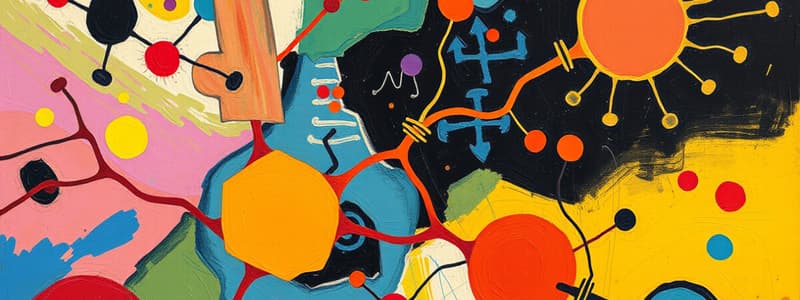Podcast
Questions and Answers
What distinguishes agonists from antagonists in receptor interactions?
What distinguishes agonists from antagonists in receptor interactions?
- Agonists and antagonists both inhibit receptor activity equally.
- Agonists can only activate nuclear receptors, but antagonists act on membrane receptors.
- Agonists increase receptor activity, while antagonists decrease it. (correct)
- Agonists have no effect on receptor activity, whereas antagonists enhance it.
Which mechanism allows lipophilic ligands to communicate intracellularly?
Which mechanism allows lipophilic ligands to communicate intracellularly?
- Utilizing protein carriers for transport across the blood-brain barrier.
- Binding to surface receptors and triggering second messengers.
- Diffusion through the plasma membrane and binding to intracellular receptors. (correct)
- Formation of ion channels in the membrane to transmit signals.
What is the primary function of the hypothalamus in relation to the pituitary gland?
What is the primary function of the hypothalamus in relation to the pituitary gland?
- To act as a storage site for hormones produced by the adrenal glands.
- To regulate the hormone secretion of the pituitary gland through releasing and inhibiting hormones. (correct)
- To produce the majority of hormones released into the bloodstream.
- To provide structural support to the hypothalamic-pituitary axis.
Which layer of the adrenal gland is responsible for producing glucocorticoids?
Which layer of the adrenal gland is responsible for producing glucocorticoids?
What is the primary difference between spermatogenesis and oogenesis?
What is the primary difference between spermatogenesis and oogenesis?
Study Notes
Chemical Messengers
- Chemical messengers are substances that facilitate communication within the body, impacting physiological processes.
- They can be classified as direct (cell-to-cell) or indirect (via intermediaries).
- Chemical signals can include hormones, neurotransmitters, and cytokines.
Mechanisms of Intracellular Communications
- Direct communication involves gap junctions allowing molecules to pass between adjacent cells.
- Indirect communication utilizes chemical messengers that bind to receptors on target cells.
Signal Transduction
- Signal transduction refers to the process by which cells respond to external signals, often involving a series of molecular events.
- Receptors are proteins that specifically bind chemical messengers, triggering a response in the cell.
Receptors
- Receptors have general properties such as specificity, affinity, and the ability to trigger changes within cells upon activation.
- Agonists activate receptors, mimicking natural messengers, while antagonists block receptor activation.
Regulation of Receptors
- Up-regulation increases the number of receptors in response to low levels of a messenger, enhancing sensitivity.
- Down-regulation decreases receptor numbers in response to high levels of a messenger, reducing sensitivity.
Lipophilic vs. Lipophobic Ligands
- Lipophilic ligands (e.g., steroid hormones) can cross cell membranes and often act on intracellular receptors.
- Lipophobic ligands (e.g., peptide hormones) cannot penetrate cell membranes and bind to surface receptors, initiating a signal cascade.
First and Second Messengers
- First messengers are chemical signals outside the cell, while second messengers are intracellular molecules that mediate the cellular response.
Endocrine System
- The endocrine system includes both primary (e.g., pituitary gland, adrenal glands) and secondary (e.g., pancreas, gonads) organs.
- The hypothalamus produces releasing hormones that regulate the pituitary gland's secretion of hormones.
Adrenal Gland Structure
- The adrenal gland has three layers:
- Zona glomerulosa (produces aldosterone),
- Zona fasciculata (produces cortisol),
- Zona reticularis (produces androgens).
Reproductive System - Male
- The male reproductive system consists of primary sex organs (testes) and secondary sex organs (penis, seminal vesicles).
- Spermatogenesis is the process through which sperm is produced in the seminiferous tubules of the testes.
Reproductive System - Female
- The female reproductive system includes primary sex organs (ovaries) and secondary sex organs (uterus, fallopian tubes).
- Oogenesis refers to the maturation of oocytes within the ovaries, while folliculogenesis is the development of ovarian follicles.
Reproductive Anatomy Pathways
- Gametes in males are transported from the testes through the epididymis and vas deferens to the urethra.
- In females, oocytes travel from the ovaries through the fallopian tubes to the uterus.
Microscopic Anatomy of the Uterus
- The uterus has three layers: endometrium (inner), myometrium (muscular layer), and perimetrium (outer lining).
Ovarian Cycle vs. Uterine Cycle
- The ovarian cycle includes follicular development and ovulation, while the uterine cycle involves changes in the endometrial lining in response to hormonal fluctuations.
Studying That Suits You
Use AI to generate personalized quizzes and flashcards to suit your learning preferences.
Description
Explore the world of chemical messengers and their role in intracellular communication. This quiz covers the basics of signal transduction, receptor properties, and differences between agonists and antagonists. Test your knowledge on the mechanisms of lipophilic and lipophobic ligands and endocrine system functions.



